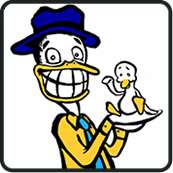When buying a diamond, you are going to pay attention to four things: clarity, color, cut, and carat. These are wittily referred to as the 4 Cs.
1. Clarity. A diamond's clarity is the primary factor in determining its price. "Clarity" refers to how easily you can see any imperfections in the diamonds, be they on the surface ("blemishes") or inside the diamond ("inclusions"). The Gemological Institute of America (GIA), the organization which sets the worldwide standards for diamonds, set up a scale: flawless, internally flawless, VVS1, VVS2, VS1, VS2, SI1, SI2, I1, I2, I3.
2. Color. The color of a diamond ranges from colorless (clear) to a faint yellow. The more colorless the diamond, the more expensive it is. The GIA also have a scale for color:
- DEF=colorless
- GHIJ=near colorless
- KLM=faint yellow
- NOPQR=very light yellow
- STUVWXYZ=light yellow
- Fancy light, fancy, fancy internal=yellow
3. Cut. This is the diamond's shape. The most popular shapes are the 58-facet round cut and oval cut (which have 58 flat faces surrounding the flat top of the diamond). Other interesting cuts include the princess cut and emerald cut (which are more square-looking). The easiest way to judge the quality of the cut is by the diamond's sparkle. The more sparkle, the better the cut and the greater the diamond's value.
4. Carat. This is how much the diamond weighs, which in turn determines its size. So think of carat = size.
One last note: when comparing diamonds, always compare them loose, and not when they're in the ring. It's easier to see imperfections that way and make sure that you don't get screwed over. And once you've picked out the ring, make sure the jeweler "plots" (draws up) all of the imperfections on a piece of paper, so you can be sure that the ring you want is the ring you get.
SoYouWanna know more? Check out our full-length article SYW buy an engagement ring?

